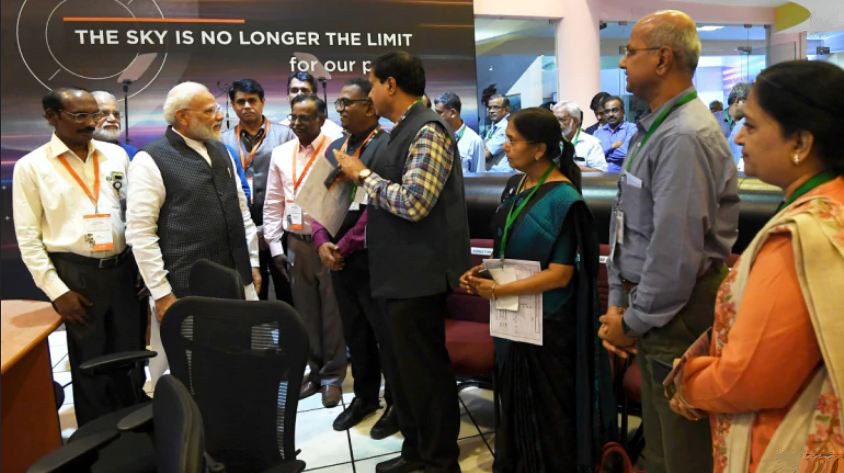Goa is abuzz with excitement as vintage bike and car owners, users, collectors and fans are decking […]

Understanding Chandrayaan-2
In the News, Sept 14- Sept 20 2019 September 13, 2019ISRO: Prime Minister Narendra Modi interacts with scientists at ISRO on Saturday, September 7, 2019. The Vikram lander was scheduled for touchdown in the early hours that day
By Amitabh Sinha
Vikram’s failure to land may have caused disappointment, but much of the Chandrayaan-2 mission remains on track. A reminder of the tasks of the orbiter, which remains functional, and some ideas on what might have happened to the lander
India’s first attempt to land a spacecraft on the Moon has not been successful. The lander of Chandrayaan-2, called Vikram, did not slow down at the expected rate towards the latter part of its descent, and most likely hit the lunar surface at a speed greater than required for safe landing. The ground control station had lost contact with the lander when it was about 2.1 km above the Moon.
On Sunday, Indian Space Research Organisation (ISRO) chairman K Sivan was quoted as saying that the lander had been located on the Moon, and a thermal image of it had been taken by instruments on board the Chandrayaan-2 orbiter that is going around the Moon in a near-circular orbit of 100 km. He said efforts to re-establish contact with the lander had not yet been successful.
So, has Chandrayaan-2 failed?
The mission has not failed, although the attempt to land a spacecraft on the Moon certainly has. The mission comprised an orbiter, a lander and rover. The orbiter part is functioning normally. Most of the scientific investigations of the mission are supposed to be carried by instruments onboard the orbiter, including studies to find more evidence of water on the Moon. The lander and rover had a mission life of only 14 days while the orbiter will function for at least one year. Scientists insist that 80-90 per cent of the science output of the mission have to come from the orbiter, and that has not been affected at all.
Is Vikram destroyed?
We don’t know as yet, but more likely than not it is. When contact was lost, it was travelling at 50 to 60 metres per second (180 to 200 km per hour). It was decelerating, but not fast enough to slow down to a speed of 2 metres/second (7.2 km/hr) that was required for a safe landing. Vikram was designed to absorb the shock of an impact even at 5 metres/second (18 km/hr). At the rate it was decelerating, it could not even have attained a speed of 5 metres/second before touchdown. It is likely to have hit the Moon at a far greater speed, possibly damaging itself and instruments on board.
So, why is ISRO still trying to look for it and re-establish contact?
For very good reasons. Science would not simply accept the assumption that the lander would have been destroyed. It would want to ascertain that, and assess the damage. Locating the lander and restoring contact is just the first step in trying to figure out what exactly happened and why.
Is it possible to do so?
The lander has already been located. At the time it had begun to deviate from its pre-programmed flight path, the lander was barely a few kilometres from the Moon. Its final point of landing, therefore, could not be away from the selected location by more than a few km. ISRO eventually used the instruments on the orbiter to locate the lander. The orbiter has only taken a thermal image —possibly because it passed over the site at a time when there was not enough sunlight —and not a normal image, which too is possible.
The more difficult part is to restore contact with the lander. That would depend on how much damage it has suffered, and whether its communication unit is intact. The individual instruments onboard the lander as well several of its components are capable of sending signals that can be picked up either through other nearby space assets or by the ground station. Every such signal will offer valuable clues to its current state and what it could have gone through.
Restoration of contact can be done only in the next two weeks. After that, the Moon will enter its night (14 Earth days) during which temperatures would be so cold that the instruments are unlikely to behave normally.
What is the best-case scenario now?
It is possible that some of the instruments on the lander are functional. It is also possible that two-way communication can be re-established with them from the ground station and they are revived. In the best-case scenario, it can be imagined that these instruments perform the functions they were intended to. The lander was supposed to remain stationary on the Moon’s surface, and the four instruments on it, installed on its different sides, were to meant to make observations and collect data. As of now, it is unlikely that the lander is standing vertically as it was supposed to. The instruments, if they can be revived, can possibly take readings and communicate with the ground station.
One of these instruments was the NASA-built Laser Retroreflector Array, essentially only a group of mirrors. This was only meant to be deployed on the Moon, not do anything. These mirrors are used by control stations on the ground to reflect signals from the Moon. At least five such reflectors are already on the Moon, deployed by earlier missions. They are used for a variety of purposes. It is by sending signals back and forth to these mirrors that the distance between the Earth and the Moon has been calculated to a very high degree of precision. All these existing retroreflectors are in the equatorial region of the Moon. The one being carried by Vikram lander would have been deployed near the polar region for the first time. If this instrument has not been totally destroyed, it can be used. It is supposed to be a “passive” instrument; it only has to act as a reflector of signals. On the other hand, the rover could have come out of the lander only when it was standing vertically. It is therefore unlikely that the rover and the two instruments on it could be put to any use now.
How big a setback this is to ISRO?
ISRO, and other space agencies as well, has gone through several such setbacks in space exploration. It is most probably a good learning experience. Even Chandrayaan-1, launched in 2008, had suffered a partial failure. It had a mission life of two years but remained functional for barely nine months. An issue with heat shielding had created problems within a few weeks of its reaching the orbit, and some of the onboard instruments had to be switched off. They were restored once but many of them developed problems again. By May 2009, less than eight months after reaching its designated orbit of 100 km from Moon’s surface, Chandrayaan-1 had to be moved to a higher orbit of 200 km. A few months later, it became almost a dead spacecraft. It is still going around the Moon but without communicating.
However, the main science objectives of Chandrayaan-1 had already been achieved by that time. This included the blockbuster finding of irrefutable evidence of presence of water on the Moon.
The science produced by the Chandrayaan-2 mission, too, might remain completely unaffected by what has happened to the lander, though the hype surrounding the landing attempt might not let people forget this failure very soon. But there would also be very important learnings for ISRO to implement in its future missions.
Courtesy: Indian Express














